Chapter 4: Inventory
Chapter learning objectives
Upon completion of this chapter you will be able to:
- explain the need for adjustments for inventory in preparing financial statements
- illustrate income statements with opening and closing inventory
- explain and demonstrate how opening and closing inventory are recorded in the inventory account
- explain the IAS 2 requirements regarding the valuation of closing inventory
- define the cost and net realisable value of closing inventory
- discuss alternative methods of valuing inventory
- explain and demonstrate how to calculate the value of closing inventory from given movements in inventory levels, using FIFO (first in first out) and AVCO (average cost)
- assess the effect of using either FIFO or AVCO on both profit and asset value
- explain the IASB requirements for inventories
- explain the use of continuous and period-end inventory records.
1 Valuation of inventory
Inventory consists of:
- goods purchased for resale
- consumable stores (such as oil)
- raw materials and components (used in the production process)
- partly-finished goods (usually called work in progress – WIP)
- finished goods (which have been manufactured by the business).
 IAS 2 Inventory
IAS 2 Inventory
Inventory is included in the statement of financial position at:
Cost
Cost includes all the expenditure incurred in bringing the product or service to its present location and condition.
This includes:
- Cost of purchase – material costs, import duties, freight.
- Cost of conversion – this includes direct costs and production overheads.
Costs which must be excluded from the cost of inventory are:
- selling costs
- storage costs
- abnormal waste of materials, labour or other costs
- administrative overheads.

 Cost vs NRV
Cost vs NRV
Example
Gordano is a small furniture manufacturing company. All of itstimber is imported from Scandinavia and there are only three basicproducts - bookcases, dining tables and cupboards. The company has 200completed bookcases in inventory at the end of the year. For finalaccounts purposes, these will be stated at the lower of cost and netrealisable value. How is 'cost' arrived at?
Solution
'Cost' will include several elements:
- Cost of purchase. First of all we must identify the timber used in the manufacture of bookcases (as opposed to dining tables and cupboards). The relevant costs will include the cost of the timber, the import duty and all the insurance and freight expenses associated with transporting the timber from Scandinavia to the factory.
- Cost of conversion. This will include costs which can be directly linked to the bookcases produced during the year. This includes labour costs ‘booked’ and sundry material costs (e.g. hinges and screws). Production overheads present particular problems. Costs such as factory heating and light, salaries of supervisors and depreciation of equipment are likely to relate to the three product ranges. These costs must be allocated to these product ranges on a reasonable basis. In particular, any percentage additions to cover overheads must be based on the normal level of production. If this provision was not made, the inventory could be overvalued at the end of a period of low production, because there would be a smaller number of items over which to spread the overhead cost.
These groups of cost must relate to either:
- bookcases sold during the year, or
- bookcases in inventory at the year-end (i.e. 200 bookcases).
NRV
The comparison between cost and NRV must be made item by item,not on the total inventory value. It may be acceptable to considergroups of items together if all are worth less than cost.


 Test your understanding 1
Test your understanding 1
Cole’s business sells three products X, Y and Z. The following information was available at the year-end:

What is the value of the closing inventory?
A $8,400
B $6,800
C $7,100
D $7,200


 Test your understanding 2
Test your understanding 2
In what circumstances might the NRV of inventories be lower than their cost?


 Test your understanding 3
Test your understanding 3
IAS 2 Inventories defines the items that may be included incomputing the value of an inventory of finished goods manufactured by abusiness.
Which one of the following lists consists only of items which maybe included in the statement of financial position value of suchinventories according to IAS 2?
A Foreman’s wages, carriage inwards, carriage outwards, raw materials
B Raw materials, carriage inwards, costs of storage of finished goods, plant depreciation
C Plant depreciation, carriage inwards, raw materials, foreman’s wages
D Carriage outwards, raw materials, foreman’s wages, plant depreciation


 Inventory valuation
Inventory valuation
Inventory valuation
It can be a complicated procedure to arrive at the valuation placed on closing inventory, because:
- Initially the existence of the inventory, and the quantities thereof, have to be ascertained by means of an inventory count.
- Following on from this, a valuation has to be placed on the inventory which, as will be seen, may differ according to whatever accounting policy a company adopts.
The matching and prudence concept
- The concept of matching justifies the carrying forward of purchases not sold by the end of the accounting period, to leave the remaining purchases to be ‘matched’ with sales.
When it comes to placing a value on the inventory carried forward, we have a further concept to consider: the prudence concept.
If it weren’t for this concept, we would carry forward inventory at its cost to the business. The prudence concept, however, requires the application of a degree of caution in making estimates under conditions of uncertainty.
In the context of the value of inventory, this means that if goodsare expected to be sold below cost after the statement of financialposition date (for example, because they are damaged or obsolete),account must be taken of the loss in order to prepare the statement offinancial position.
The amount at which inventory should be stated in the statement offinancial position is the lower of cost and net realisable value.


 Inventory records
Inventory records
Keeping inventory records
A business may choose to keep inventory records on a continuousbasis throughout the year or only count inventory at the period end.
In preparing the financial statements, the calculation of what isin closing inventory can be a major exercise for a business. Thebusiness may need to count its inventory at the statement of financialposition date. A formal title for the sheets recording the inventorycount is ‘period-end inventory records’.
An alternative would be to have records which show the amount ofinventory at any date, i.e. continuous inventory records. These recordsmay take a variety of forms but, in essence, a record of each item ofinventory would be maintained showing all the receipts and issues forthat item.
The merits of continuous inventory records are as follows:
- There is better information for inventory control.
- Excessive build up of certain lines of inventory whilst having insufficient inventory of other lines is avoided.
- Less work is needed to calculate inventory at the end of the accounting period.
The merits of period-end inventory records are as follows:
- They are cheaper in most situations than the costs of maintaining continuous inventory records.
- Even if there is a continuous inventory record, there will still be a need to check the accuracy of the information recorded by having a physical check of some of the inventory lines.

2 Adjustments for inventory in the financial statements
- In order to be able to prepare a set of financial statements, inventory must be accounted for at the end of the period.
- Opening inventory must be included in cost of sales as these goods are available for sale along with purchases during the year.
- Closing inventory must be deducted from cost of sales as these goods are held at the period end and have not been sold.

 Profit
Profit
In order to be able to prepare a set of financial statements, itis first necessary to learn how to account for any items of goods heldat the end of the year, i.e. closing inventory. (In some countriesinventory is referred to as ‘stock’.)
Example
A trader starts in business and by the end of his first year hehas purchased goods costing $21,000 and has made sales totalling$25,000. Goods which cost him $3,000 have not been sold by the end ofthe year.
What profit has he made in the year?
Solution
The unsold goods are referred to as closing inventory. This inventory is deducted from purchases in the income statement.
Gross profit is thus:

Closing inventory of $3,000 will appear on the statement of financial position as an asset.


 Illustration 1 – Adjustments for inventory
Illustration 1 – Adjustments for inventory
Peter buys and sells washing machines. He has been trading formany years. On 1 January 20X7, his opening inventory is 30 washingmachines which cost $9,500. He purchased 65 machines in the yearamounting to $150,000 and on 31 December 20X7 he has 25 washing machinesleft in inventory with a cost of $7,500. Peter has sold 70 machineswith a sales value of $215,000 in the year.
Calculate the gross profit for the year ended 31 December 20X7.


 Solution
Solution
Solution
- Gross profit is sales revenue less cost of sales.
- We must match the 70 machines sold with the cost of those machines and exclude from cost of sales the machines that are left in inventory.
- Opening inventory must be included in cost of sales as some of the goods sold during the year come from the goods the trader started off with at the beginning of the year.
- We can calculate the gross profit as follows:
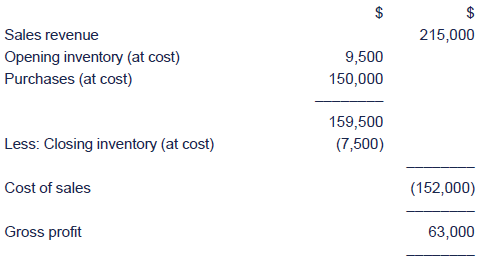

 3 Recording inventory in the ledger accounts
3 Recording inventory in the ledger accounts
- Once these entries have been completed, the income statement ledger account contains both opening and closing inventory and the inventory ledger account shows the closing inventory for the period to be shown in the statement of financial position.

 Illustration 2 – Recording inventory in the ledger accounts
Illustration 2 – Recording inventory in the ledger accounts
Continuing from previous Illustration, we will now see how the ledger accounts for inventory are prepared.
We will look at the ledger accounts at the following times:
(a)Immediately before extracting a trial balance at 31 December 20X7.
(b)Immediately after the year-end adjustments and closing off of the ledger accounts.
(a)Ledger accounts before extracting a trial balance

The inventory is an asset and therefore is a debit entry in the inventory account.


- The balance of $9,500 in inventory account originated from last year’s statement of financial position when it appeared as closing inventory. This figure remains unchanged in the inventory account until the very end of the year when closing inventory at 31 December 20X7 is considered.
- The closing inventory figure is not usually provided to us until after we have extracted the trial balance at 31 December 20X7.
- The purchases and sales figures have been built up over the year and represent the year’s accumulated transactions.
- The trial balance will include opening inventory, purchases and sales revenue in respect of the inventory transactions.
(b) Ledger accounts reflecting the closing inventory
- Closing inventory for accounting purposes has been valued at $7,500.
Step 1
The income statement forms part of the double entry. At the yearend the accumulated totals from the sales and purchases accounts must betransferred to it using the following journal entries:

These transfers are shown in the ledger accounts below.
Step 2
The opening inventory figure ($9,500) must also be transferred tothe income statement account in order to arrive at cost of sales.
Dr Income statement $9,500 Cr Inventory $9,500
Step 3
The income statement cannot be completed (and hence gross profit calculated) until the closing inventory is included.
Dr Inventory $7,500 Cr Income statement $7,500
After summarising and balancing off, the ledger then becomes:






 Key points
Key points
Key points:
- The sales revenue and the purchases accounts are cleared out to and summarised in the income statement.
- Opening inventory is cleared out to the income statement and closing inventory is entered into the inventory account and the income statement.
- The balance on the inventory account remains at the end of the period and is listed in the statement of financial position under current assets as inventory.
- The first part of the income statement can be balanced at this stage to show the gross profit figure carried down and brought down.
- The above layout of the income statement is not particularly useful, but it assists the appreciation of the actual double entry processes and the realisation that the income statement is part of the double entry.
The more common layout of the first part of the income statement is:
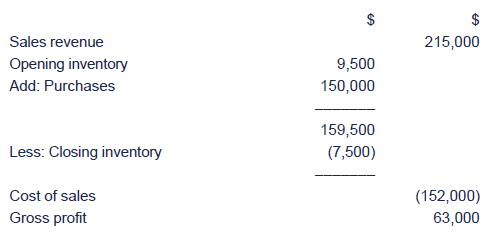


 Test your understanding 4
Test your understanding 4
The trading position of a simple cash-based business for its first week of trading was as follows:

At the end of the week there were goods which had cost $300 left in inventory.
Write up the ledger accounts for the first week, including theincome statement, and then prepare a vertical income statement togetherwith a statement of financial position at the end of the first week.


 Test your understanding 5
Test your understanding 5
The business described in Test your understanding 1 now continues into its second week. Its transactions are as follows:

The goods left in inventory at the end of this second week originally cost $500.
Write up the ledger accounts for the second week, including theincome statement, and then prepare a vertical income statement togetherwith a statement of financial position at the end of the second week.

4 Drawings of inventory
It is not unusual for a sole trader to take inventory from theirbusiness for their own use. This type of transaction is a form ofdrawings.
The correct double entry to account for such drawings is:

The credit entry ensures that the cost of inventory taken is notincluded as part of the cost of inventory sold in the income statement.
5 Methods of calculating cost of inventory
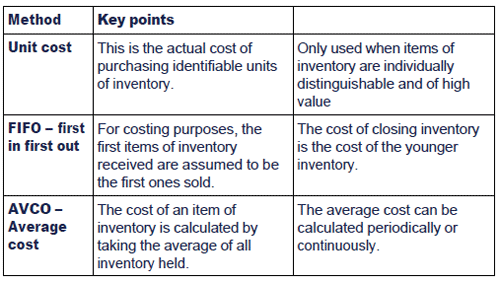

 Test your understanding 6
Test your understanding 6
Sam started her business on 1 January and provides details of the following transactions:
Purchases
(1) January 5 units at $4/unit
(2) January 5 units at $5/unit
(3) January 5 units at $5.50/unit
She then sold 7 units for $10/unit on 5 January.
(a) Calculate the value of the closing inventory at the end of the first week of trading using the FIFO and the AVCO methods.
(b) Prepare the income statement for the first week of trading under both FIFO and AVCO.


 Test your understanding 7
Test your understanding 7
A business commenced on 1 January and purchases are made as follows:
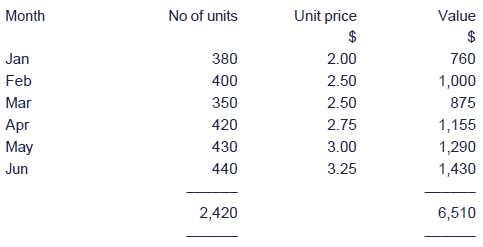
In June, 1,420 articles were sold for $7,000.
What is the cost of closing inventory and gross profit for the period using the FIFO method:



 Profit and Statement of financial position
Profit and Statement of financial position
The impact of valuation methods on profit and the statement of financial position.
Different valuation methods will result in different closing inventory values.
This will in turn impact both profit and statement of financial position asset value.
Similarly any incorrect valuation of inventory will impact the financial statements.
If inventory is overvalued then:
- assets are overstated in the statement of financial position
- profit is overstated in the income statement (as cost of sales is too low)
If inventory is undervalued then:
- assets are understated in the statement of financial position
- profit is understated in the income statement (as cost of sales is too high).

6 Disclosure
Inventories
Inventories are valued at the lower of cost and net realisablevalue. They will be analysed as follows in the notes to the accounts:
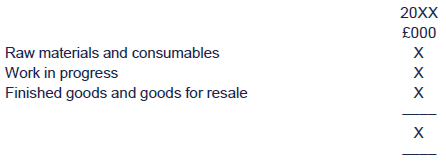
Chapter summary
Test your understanding answers

 Test your understanding 1
Test your understanding 1
The correct answer is B



 Test your understanding 2
Test your understanding 2
NRV may be relevant in special cases, such as where goods areslow-moving, damaged or obsolete. However, most items of inventory willbe stated at cost.


 Test your understanding 3
Test your understanding 3
The correct answer is C
The other three answers contain items which cannot be included in inventory according to IAS 2.


 Test your understanding 4
Test your understanding 4
First, the transactions are entered into the ledger accounts, andthe accounts are balanced. Revenue and purchases are then transferredto the income statement ledger account.

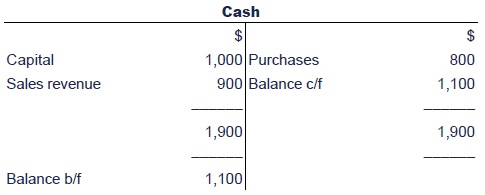


Next, the closing inventory must be accounted for in the inventoryaccount and the income statement account. There is no opening inventoryas this is the first week of trading for the business.

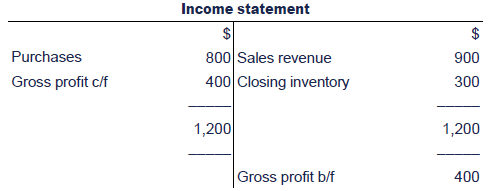
The income statement is prepared in the vertical format by rearranging the income statement ledger account

The statement of financial position is prepared by listing the balances brought down from the ledger accounts.



 Test your understanding 5
Test your understanding 5
First, the ledger accounts must be written up. You must rememberthat there are opening balances on the statement of financial positionaccounts (cash and capital) but the income statement accounts have noopening balances as they were transferred to the income statement inWeek 1.
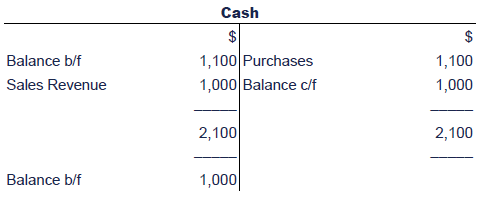



The opening inventory must be transferred to the income statement,and the closing inventory entered into the ledger accounts (inventoryand income statement) leaving the balance carried forward which will beincluded in the statement of financial position.

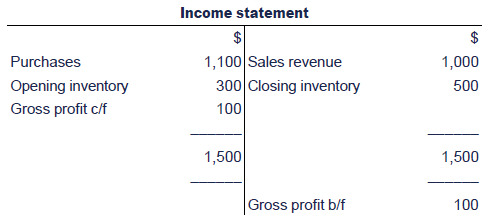

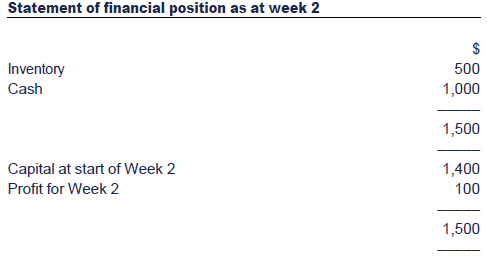


 Test your understanding 6
Test your understanding 6
Units purchased (5 x 3) = 15

(a) FIFO
AVCO Average cost per unit: ((5 x $4) + (5 x $5) + (5 x $5.50))/15 = $4.83
Closing inventory = 8 x $4.83 = $38.64
(b) FIFO
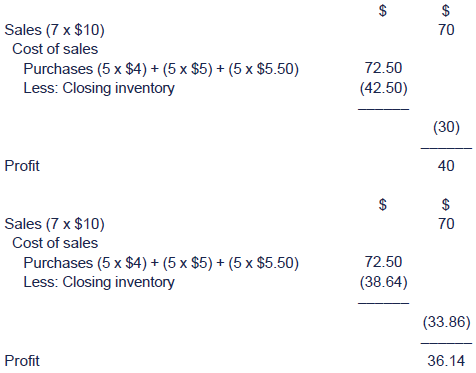


 Test your understanding 7
Test your understanding 7
- The correct answer is C
- Inventory valuation (inventory in hand 2,420 – 1,420 = 1,000 units)
- FIFO – inventory valued at latest purchase prices

Calculation of gross profit:
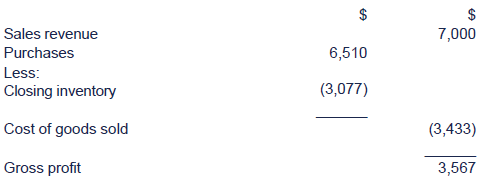

|
Created at 5/24/2012 3:31 PM by System Account
(GMT) Greenwich Mean Time : Dublin, Edinburgh, Lisbon, London
|
Last modified at 5/25/2012 12:53 PM by System Account
(GMT) Greenwich Mean Time : Dublin, Edinburgh, Lisbon, London
|
|
|
|
 |
Rating
:
|
 Ratings & Comments
(Click the stars to rate the page) Ratings & Comments
(Click the stars to rate the page)
|
 |
Tags:
|
|
|
|
|